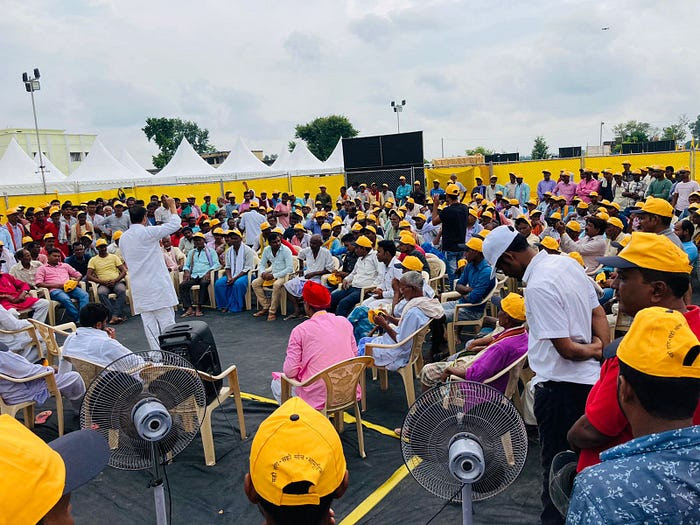Is Bihari a cuss word ?
You are Here: Tweet, Like, Share, Comment, Subscribe…be the Voice of Free Press!
Fiza Alam Zaidi, The India observer, TIO, NJ: Yes it is , in-fact the term “Bihari” in the recent years is increasingly being used as a cuss word to equate the state’s economic backwardness as cultural backwardness, and to glorify the supremacy of Hindi speakers living in the culturally (Debatable) prosperous regions of Hindi heartland of the country to generalize everything associated with Bihar as degrading and impoverishing in perpetual state of poverty.
Also Read, Tweet & Share: Centre clears 10% quota for economically weak in general category
We frequently overlook the fact that the Hindi Heartland was patronized by the mediaeval imperial powers, giving it an advantage over other areas due to its wealth of natural resources and proximity to Delhi. The lack of a patronizing person in Bihar region.

Prashant Kishore on a Padayatra across the State of Bihar
Also Read, Tweet & Share: Bihar: One of India’s most politically volatile states.
Bihar is the land which produces the highest no. of cheap labor in the country simply because there is little or no employment in Bihar and most erstwhile rich folks have managed to climb the social ladder because of their affluence, hard work and farsightedness. There is a very popular phrase about Bihari people , that is “Either they are Babus (Civil servants) or they are mazdoor (laborers)”, which symbolically represents if given fair and equal chances people here can climb up in the social ladder as neither do they lack brains nor hard work. Meanwhile this desire of climbing the social ladder is now being capitalized in every nook and corner of Patna. The city features a colossal number of coaching institutes for the IAS, IPS, NEET, CLAT, NIFT, and PCS exams.
Also Read, Tweet & Share: Kashmir is Pakistan’s ‘jugular vein’: Prime Minister Imran Khan
People who can’t afford Delhi or Kota send their kids to Patna. Yesterday I met a bunch of students from one of the many coaching institutes in Boring Road and Frazer Road where I have been living for almost a month now. It was absolutely revolutionary and inspiring to witness a bunch of youth fighting to erase the usage of the term “Bihari” as a cuss word from the minds of people and what an elevation it was.
Also Read, Tweet & Share: Muslims of Tamil Nadu – History, Social Structure, and Current Status
The way in which social identities have been shaped in Bihar can only be understood by reviewing it with the political cleavages and the role of political context in which Bihari realities have been shaped. The rise of the Lower Castes in North India dates back to the rise of the era of Mandal politics. In other words, the politics that followed since 1990 is largely the politics of reassertion and reaffirmation of old caste cleavages, deepened further to capture political power.
Also Read, Tweet & Share: Bihar- Five Muslims get Ministerial Berth- Operation Lotus Fails
People now tended to vote more for identity (of caste) than for non-parochial issues such as good governance, improvement in the material conditions of people, betterment of and universal access to health and educational facilities and universal provisions of basic amenities. Bihar might be economically and educationally, one of the most backward states but politically it is one of the most important states.
Also Read, Tweet & Share: Encephalitis deaths: SC directs Centre, Bihar, UP governments to respond within a week
Organically there is a natural non justified rivalry between the East and the West , whether it is the eastern part of the world where India lies or the east part of India which starts from Bihar and goes on Arunachal Pradesh and Nagaland touching the Burma border.
There is a direct relationship between the economic backwardness in the state and the social outlook of the more economically prosperous regions in the country. The lack of skilled human resources within the state and the mass migration of both skilled and unskilled resources has largely contributed to the perspective in which Bihari culture can be looked down upon.
Also Read, Tweet & Share: DGP Gupteshwar Pandey personifying Chulbul Pandey in Bihar
Historically speaking there are numerous reasons as to why the cultural and political supremacy of the region diminished. Bihar was included into the Bengal Presidency as a result of the acquisition of Bengal during the Battle of Plassey in 1757, which was cemented by the Battle of Buxar in 1764. The region degraded to its zenith after the annexation by the English East India company. Bihar was treated as a Hinterland for agriculture and its cultural independence was diluted and subsequently absorbed in the process. Bihar despite having an abundance of natural resources never had a successful history of Industrialization.
Also Read, Tweet & Share: Migrant From Bihar Allegedly Beaten to Death by Mob in Surat Amid Mass Exodus of Workers
As the population started expanding in the post Independence era mass migration followed. This region of the country was left out from the technological advancements of the other regions of the country as a result it kept lagging behind.
There was no serious attempt to exempt Bihar out of the ravages of underdevelopment and poverty. And the cherry on the top was the caste system which remained a pot belly for elections and garnering votes. The prejudices and stereotypes which are associated with the Bihari culture are a part and parcel of the history of underdevelopment and social stigmatization which the region suffered from.
Also Read, Tweet & Share: BJP Floats Bihar Seat-Share Math. Gets ‘F’ From Nitish Kumar’s Party
It was partly made possible by incompetent administrations, the caste system, and the persistence of colonial-era discrimination, all of which contributed to the chronic problem in which Bihar lives and strives.
About The Author : The author is Fiza Alam Zaidi , a political consultant at IPAC , currently working in the Bihar office .
Also, Read more from this Author: Bihar: One of India’s most politically volatile states.
Curated and Compiled by Humra Kidwai
Articles written by contributors have different viewpoints. The views expressed in the articles are the author’s own and not necessarily supported by TIO, The India Observer its affiliates, staff, or the management. Our Articles can be reproduced, with the following conditions, (1) No alteration to the content, (2) Visible, and full credit is given to the Author & Editor. (3) Citing, The India Observer, TIO. In the case of online or electronic media, a link to the original article must be given. Rules are strictly enforced. Any questions, email the Editor at: Mediaiss@gmail.com Or TheIndiaObserver@gmail.com
All Copyrights reserved. Please be guided.




